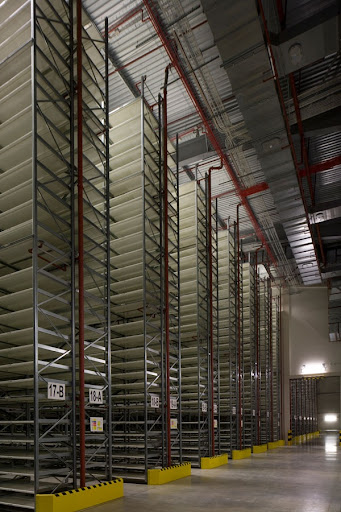The Bodleian Library at Oxford University in England has (amongst its many activities) the function of repository for all books published in that country. One copy must, by law, be sent to the Bodleian for storage and future reference. (The Library of Congress performs this function in the USA.)
Given that the Bodleian has been in existence for many centuries, and has been accumulating reference resources and all those published books, it was running out of space - fast. Today it announced its solution to the problem.
The Bodleian Libraries of the University of Oxford today unveiled its new £26-million [about US $41.3 million] Book Storage Facility (BSF), capable of holding 8.4 million volumes on 153 miles of shelving.
The new book warehouse, in South Marston, near Swindon, will store lower-usage items from the Libraries’ collections that had overwhelmed the existing bookstacks and required additional temporary storage in various locations in and outside Oxford. These collections will now be brought together at the BSF, including books, maps, manuscripts, microfilms, periodicals and newspapers primarily from the 18th century onwards. Over the next year nearly 6 million books will be moved into the BSF in what will be the biggest book move in the Bodleian’s history (see Book Moves).
The Book Storage Facility consists of a 11-metre tall solid shelving system comprising 31 Very Narrow Aisles (VNA), with seven different bay type configurations to accommodate the different sizes of books and other materials. It also has a capacity equivalent to 153 miles (230 kilometres) of shelf space and a five level multi-tier structure for map storage. To guarantee the books’ preservation for the long-term, volumes will be stored in 745,000 bar-coded and specially designed storage trays and boxes that are of archival standard. Floor area of the warehouse equates to 1.6 football pitches although the High-Density shelving provides shelf surface area equivalent to 16.5 football pitches.
The decision to site the facility outside Oxford has been informed by the new academic strategy for the Libraries. This focuses on increasing the overall speed of access to information by providing direct access to high-demand print collections, increased online access to materials, and electronic document delivery. As a result of this strategy, the BSF will be used to house low-use collections, many of which have electronic copies available.
There are more photographs at the link. The statistics of the new facility are a bit staggering:
Racking:
- 11.4m (37½ feet) high, aisle length 71 metres (233 feet)
- 31 Aisles totalling 3,224 bays with 95,000 shelf levels
- 2,196 tons of steel
- 4550m of safety rail
- Over 25,000 nuts and bolts
- Over 1,000.000 rivets
- Over 18,000 floor fixings
* Archived microfilm to be stored - 1600 linear metres [about 5,250 feet, or almost a mile]
* 600 map cabinets to hold over 1.2 million maps and large format items
* Cables - 49,500 metres [about 162,400 feet, or 30¾ miles] of fire alarm, sub mains, lighting, power and security cables.
I can only hope they make progress on digitizing their collection for computerized access, so that the facility can turn into a warehouse without much in the way of retrieval. I should think that going up and down to get at those top shelves must be something of an occupational hazard!

Peter



No comments:
Post a Comment